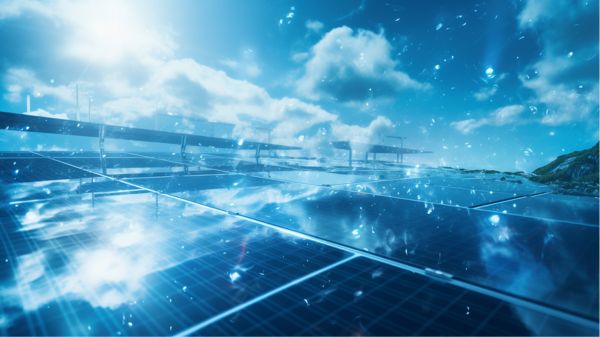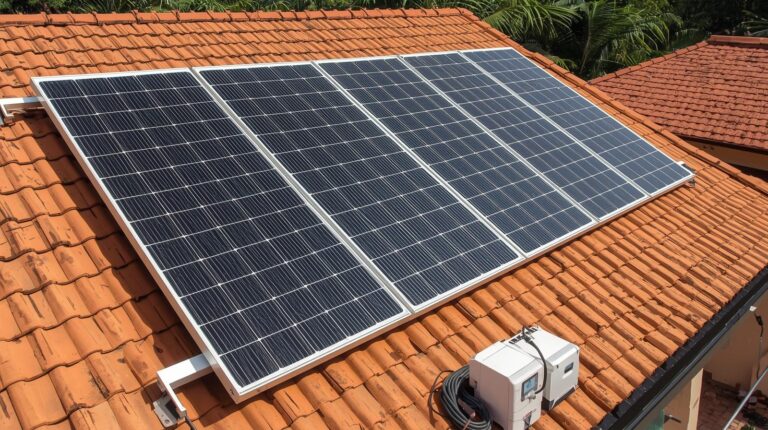The process of photovoltaic conversion is a fascinating interplay of physics and technology, where the seemingly simple sunlight is intricately transforming into usable electrical energy. Today, we’ll be discussing the process of how do photovoltaic cells convert sunlight.
At the heart of this process are the semiconductor materials that absorb photons and liberate electrons, initiating a flow of electric current. However, the real intrigue lies not just in this initial interaction but in how these materials are engineered to maximize efficiency and output.
The subtle complexities involved in the configuration of these systems reveal a deep interconnection between material science and energy sustainability. As we consider the implications for future energy solutions, one must wonder what advancements in semiconductor technology might further revolutionize our capacity to harness solar power.
Key Takeaways
- Photovoltaic conversion begins when semiconductor materials absorb the sunlight, exciting electrons to higher energy states.
- Excited electrons create electron-hole pairs within the semiconductor.
- Internal electric fields at the PN junction direct these electrons towards the n-type layer, generating direct current (DC).
- The DC then converts into alternating current (AC) using inverters for compatibility with electrical grids.
- Efficiency of the process varies, with some advanced materials achieving conversion efficiencies close to 50%.
Understanding Photovoltaic Cells
Photovoltaic cells, integral components in the conversion of solar energy to electrical power, primarily comprise semiconductor materials such as silicon. These cells harness the photovoltaic effect, a phenomenon in which photons with energies exceeding 1.1 electron volts (eV) excite electrons, creating electron-hole pairs.
This movement of electrons under the influence of a built-in electric field at the pn junction—the boundary where p-type and n-type semiconductor materials meet—generates electricity.
The core of the energy conversion process in photovoltaic cells lies in their ability to convert incident solar radiation into usable electrical energy effectively. The efficiency of solar photovoltaic conversion varies, influenced by the cell composition and structure. For instance, monocrystalline cells typically offer higher efficiency compared to polycrystalline or amorphous silicon cells.
Advanced materials like cadmium telluride and copper indium gallium selenide further push the boundaries, with efficiencies nearing 50% under experimental conditions. Additionally, the integration of solar systems into existing power grids is becoming more streamlined, enhancing the practicality of widespread solar adoption.
Standard testing conditions, such as those defined by the AM 1.5 spectrum, guarantee uniformity in measuring performance metrics like open circuit voltage and short circuit current, essential for comparing different photovoltaic technologies. These measures help in understanding and enhancing the photovoltaic conversion process, steering toward ideal utilization of solar energy.
Sunlight Absorption Mechanism
The process of sunlight absorption in solar cells marks the initial essential step toward electrical energy generation. This phase is fundamental in the photovoltaic conversion mechanism, where sunlight is converted into electrical energy through the interaction with semiconductor materials such as silicon.
In this process, photons from sunlight, each carrying energy greater than 1.1 eV, are vital as they have the potential to excite electrons within the semiconductor. High-efficiency photovoltaic cells are particularly effective at maximizing this photon-electron interaction, leading to increased energy conversion rates.
Upon the incidence of sunlight on the photovoltaic cell, these photons transfer their energy to electrons. This energy allows electrons to shift from a lower-energy valence band to a higher-energy conduction band, effectively generating electron-hole pairs. These pairs are key to creating the electrical current that is ultimately harnessed.
The efficiency of this absorption process is greatly influenced by the physical properties of the cell. Factors like surface reflectance and the crystalline structure of the semiconductor play pivotal roles. Minimizing energy losses through ideal design is essential for maximizing efficiency.
Additionally, spectral responsivity curves provide insights into how different wavelengths of light impact absorption, revealing variations in efficiency based on the spectral quality of the incident sunlight. This understanding aids in enhancing solar cells to better harness varying light conditions.
Electron Excitation and Flow
Upon absorption of sunlight, a significant transformation occurs within the semiconductor material of a solar cell: electrons are excited to higher energy states. This fundamental step in photovoltaic conversion is essential for the generation of electric current.
When photons hit the surface of a photovoltaic cell, typically made of silicon, they impart enough energy (approximately 1.1 eV for silicon) to electrons, enabling these negatively charged particles to break free from their atomic bonds. This process generates electron-hole pairs, necessary for the flow of electricity.
The technological advancements in solar panels have markedly improved their efficiency and functionality, making the process more effective than ever.
Here are three important aspects of electron excitation and flow:
- Energy Absorption: Electrons in the semiconductor material absorb energy from sunlight, which elevates them from the valence band to the conduction band, creating free carriers of electricity.
- Creation of Electron-Hole Pairs: The energized state results in the separation of electron-hole pairs, integral to establishing an electric current within the solar cell.
- Direct Current Generation: The movement of these free electrons towards the n-type layer and holes towards the p-type layer generates a direct current (DC), which can be converted into usable power.
This electron excitation and subsequent flow are essential for transforming solar energy into electrical energy in photovoltaic cells.
Internal Electric Fields
In photovoltaic cells, the pn junction plays an essential role in establishing internal electric fields critical for the operation of the device.
These fields effectively manage the dynamics of charge carriers, separating electrons and holes to facilitate the flow of electric current upon photon absorption.
The effectiveness of these field effect mechanisms is directly influenced by the material quality and structural integrity of the semiconductor used.
PN Junction Role
Central to the operation of photovoltaic cells, the PN junction serves as a vital interface where p-type and n-type semiconductors meet, establishing an internal electric field essential for solar energy conversion.
This internal electric field is a pivotal factor in the manipulation and movement of charge carriers within the solar cell, directly impacting the device’s efficiency and performance.
Key Roles of the PN Junction in Photovoltaic Cells:
- Separation of Charge Carriers: The internal electric field created at the PN junction efficiently drives the separation of electron-hole pairs generated when photons strike the solar cell. This separation is important for preventing recombination and ensuring that these carriers contribute to the electric current.
- Directional Movement: Electrons are pushed towards the n-type layer while holes move to the p-type layer, facilitating a directional flow of charge carriers that forms the basis of electrical current in photovoltaic cells.
- Enhancement of Solar Cell Efficiency: By minimizing recombination losses and maximizing carrier separation, the electric field across the PN junction greatly enhances the overall efficiency and effectiveness of the solar energy conversion process, influencing important performance metrics like open-circuit voltage and short-circuit current.
Charge Carrier Dynamics
Building on the foundational role of the PN junction in photovoltaic cells, the dynamics of charge carriers within these devices further elucidate the mechanisms of solar energy conversion.
Internal electric fields, inherent to the structure of photovoltaic cells, play a pivotal role in directing the movement of these carriers, which include both electrons and holes. The directionality imposed by these fields—electrons to the n-type layer and holes to the p-type layer—is vital for the generation of electrical power.
The efficiency of this process is heavily dependent on the material properties of the semiconductor and the dynamics of the carrier recombination. Recombination, a process where electrons and holes combine, can lead to significant losses in output power if not properly managed.
The quality of the semiconductor material therefore directly impacts the effectiveness of the internal electric fields in facilitating carrier separation and minimizing recombination.
| Feature | Importance in PV Cells |
|---|---|
| Internal Electric Fields | Direct charge carriers |
| Carrier Recombination | Affects output power |
| Semiconductor Material | Influences efficiency |
| Charge Carrier Movement | Generates electric current |
Optimizing these elements is essential for enhancing the performance and energy liberation potential of photovoltaic systems.
Field Effect Mechanisms
Photovoltaic cells harness solar energy through a vital internal mechanism: the generation of electric fields within the pn junction. This integral feature of solar cells plays a pivotal role in photovoltaic conversion, dictating the movement and separation of electron-hole pairs essential for generating electrical power.
When photons of sufficient energy strike the semiconductor material, they elevate electrons, creating these pairs. The internal electric fields then efficiently segregate these, propelling electrons toward the n-type layer and holes toward the p-type layer, culminating in a flow of direct current.
Key aspects of internal electric fields in photovoltaic conversion include:
- Charge Separation: The field across the pn junction acts as a barrier that separates electron-hole pairs generated by photon absorption. This spatial separation is essential for preventing immediate recombination and is fundamental to generating usable electrical energy.
- Directional Movement: The orientation and strength of the internal electric fields determine the directional flow of charge carriers. This alignment is vital for the efficient transport of charges to their respective electrodes, thereby optimizing the output current of the solar cell.
- Influence on Efficiency: The design and intrinsic properties of the semiconductor material affect how internal electric fields manage carrier diffusion and recombination. Enhancements in these properties directly correlate with improvements in the overall efficiency of photovoltaic conversion, highlighting the importance of material science innovations in solar technology.
Direct Current Generation
The process of direct current generation in photovoltaic systems initiates when solar energy activates electrons within the semiconductor material of a solar cell, typically silicon.
This excitation creates electron-hole pairs, whereupon the built-in electric field of the pn junction propels these electrons towards the n-type layer, culminating in a stream of electric current. This flow is inherently direct current (DC), characterized by the unidirectional movement of electrons from the solar cell’s negative to positive terminals.
Efficiency and output in photovoltaic conversion are contingent on multiple variables. Here is a succinct overview:
| Factor | Impact on DC Generation | Typical Range |
|---|---|---|
| Light Intensity | Higher intensity increases output | Varied |
| Sunlight Angle | Ideal angles enhance efficiency | Dependent on location |
| Cell Efficiency | Higher efficiency yields more energy | 6% – 25% |
Each solar cell within a panel works collectively, configured in series and parallel arrangements, to amplify the voltage and current. This configuration is pivotal for harnessing and utilizing solar power effectively, making photovoltaic systems a cornerstone in the pursuit of energy efficiency and sustainable power generation.
Conversion to Alternating Current
Solar cells within a photovoltaic system primarily generate direct current (DC); however, for integration with household appliances and the broader electrical grid, this DC must be transformed into alternating current (AC). This transformation is critical because most domestic and industrial devices are designed to operate on AC, not the DC produced by solar panels.
The conversion process employs an inverter, a device pivotal to photovoltaic systems. Here’s how it functions:
- Conversion Mechanism: The inverter takes DC electricity from the solar panels and uses power electronics to change the current flow direction at a rapid pace. This action creates a sinusoidal AC waveform that synchronizes with the grid frequency—60 Hz in North America and 50 Hz elsewhere.
- Efficiency and Technology: Modern inverters integrate maximum power point tracking (MPPT) technology, enhancing the photovoltaic system’s overall efficiency. MPPT optimizes the power output by adjusting the electrical operating point of the modules, adapting to changes in sunlight exposure.
- Performance Monitoring: Many high-end inverters also include monitoring systems that provide real-time data on energy production and system performance. This feature aids users in maximizing their conversion efficiency and managing their solar energy utilization effectively.
These features collectively guarantee that the conversion from DC to AC is both efficient and effective, aligning with the needs of a grid-connected photovoltaic system.
Applications and Innovations
Utilizing photovoltaic systems across diverse settings, from isolated cabins to large-scale industrial power plants, showcases their remarkable adaptability and broad spectrum of applications. These systems, integral to varying scales of energy generation, demonstrate a capacity for customization, meeting both microwatt needs in small devices and megawatt demands in power grids.
The integration of energy storage solutions with photovoltaic systems marks a significant stride towards enhancing both the reliability and efficiency of solar power. This synergy guarantees a consistent electricity supply, vital during periods when solar irradiance is low, thereby stabilizing the grid and reducing dependency on traditional energy sources.
Advancements in solar technology further push the boundaries of photovoltaic efficiency. Tandem solar cells and selective emitters are essential in this quest, optimizing performance and reducing costs while maximizing energy capture. Such innovations are not merely incremental; they are transformative, offering substantial leaps in the application and effectiveness of photovoltaic installations.
Moreover, the development of hybrid PV-thermal systems, which incorporate liquid filtering to harness both light and heat, exemplifies the innovative spirit driving the solar industry forward.
These systems exemplify how ongoing research and material advancements continue to expand the utility and application of solar energy solutions, guaranteeing their vital role in a sustainable energy landscape.
Conclusion
In summary, the photovoltaic conversion process is a sophisticated sequence involving the absorption of sunlight by semiconductor materials, excitation of electrons, and the creation of electron-hole pairs. These pairs are directed by internal electric fields towards different layers, generating direct current.
Subsequently, this current converts into alternating current through inverters for grid compatibility. The efficacy of this process is influenced by material properties, light intensity, and the configuration of the photovoltaic system, driving ongoing innovations and applications in solar technology.




